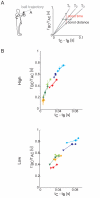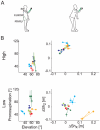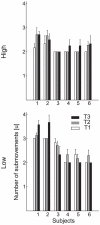Catching a ball at the right time and place: individual factors matter
- PMID: 22384072
- PMCID: PMC3285177
- DOI: 10.1371/journal.pone.0031770
Catching a ball at the right time and place: individual factors matter
Abstract
Intercepting a moving object requires accurate spatio-temporal control. Several studies have investigated how the CNS copes with such a challenging task, focusing on the nature of the information used to extract target motion parameters and on the identification of general control strategies. In the present study we provide evidence that the right time and place of the collision is not univocally specified by the CNS for a given target motion; instead, different but equally successful solutions can be adopted by different subjects when task constraints are loose. We characterized arm kinematics of fourteen subjects and performed a detailed analysis on a subset of six subjects who showed comparable success rates when asked to catch a flying ball in three dimensional space. Balls were projected by an actuated launching apparatus in order to obtain different arrival flight time and height conditions. Inter-individual variability was observed in several kinematic parameters, such as wrist trajectory, wrist velocity profile, timing and spatial distribution of the impact point, upper limb posture, trunk motion, and submovement decomposition. Individual idiosyncratic behaviors were consistent across different ball flight time conditions and across two experimental sessions carried out at one year distance. These results highlight the importance of a systematic characterization of individual factors in the study of interceptive tasks.
Conflict of interest statement
Figures








Similar articles
-
Grasping in One-Handed Catching in Relation to Performance.PLoS One. 2016 Jul 8;11(7):e0158606. doi: 10.1371/journal.pone.0158606. eCollection 2016. PLoS One. 2016. PMID: 27392041 Free PMC article. Clinical Trial.
-
Errors in the control of joint rotations associated with inaccuracies in overarm throws.J Neurophysiol. 1996 Mar;75(3):1013-25. doi: 10.1152/jn.1996.75.3.1013. J Neurophysiol. 1996. PMID: 8867114
-
Advance knowledge effects on kinematics of one-handed catching.Exp Brain Res. 2010 Apr;201(4):875-84. doi: 10.1007/s00221-009-2102-0. Epub 2009 Dec 1. Exp Brain Res. 2010. PMID: 19949776
-
A new ball launching system with controlled flight parameters for catching experiments.J Neurosci Methods. 2011 Mar 30;196(2):264-75. doi: 10.1016/j.jneumeth.2011.01.013. Epub 2011 Jan 21. J Neurosci Methods. 2011. PMID: 21256864
-
Visual factors in hitting and catching.J Sports Sci. 1997 Dec;15(6):533-58. doi: 10.1080/026404197366985. J Sports Sci. 1997. PMID: 9486432 Review.
Cited by
-
Implicit guidance to stable performance in a rhythmic perceptual-motor skill.Exp Brain Res. 2015 Jun;233(6):1783-99. doi: 10.1007/s00221-015-4251-7. Epub 2015 Mar 28. Exp Brain Res. 2015. PMID: 25821180 Free PMC article.
-
Interindividual differences in incentive sensitivity moderate motivational effects of competition and cooperation on motor performance.PLoS One. 2020 Sep 18;15(9):e0237607. doi: 10.1371/journal.pone.0237607. eCollection 2020. PLoS One. 2020. PMID: 32946448 Free PMC article.
-
The Effects of Reducing Preparation Time on the Execution of Intentionally Curved Trajectories: Optimization and Geometrical Analysis.Front Hum Neurosci. 2017 Jun 29;11:333. doi: 10.3389/fnhum.2017.00333. eCollection 2017. Front Hum Neurosci. 2017. PMID: 28706478 Free PMC article.
-
Increased Throwing Accuracy Improves Children's Catching Performance in a Ball-Catching Task from the Movement Assessment Battery (MABC-2).Front Psychol. 2016 Jul 28;7:1122. doi: 10.3389/fpsyg.2016.01122. eCollection 2016. Front Psychol. 2016. PMID: 27516750 Free PMC article.
-
Gaze behavior in one-handed catching and its relation with interceptive performance: what the eyes can't tell.PLoS One. 2015 Mar 20;10(3):e0119445. doi: 10.1371/journal.pone.0119445. eCollection 2015. PLoS One. 2015. PMID: 25793989 Free PMC article.
References
-
- Lacquaniti F, Soechting JF, Terzuolo SA. Path constraints on point-to-point arm movements in three-dimensional space. Neuroscience. 1986;17:313–324. - PubMed
-
- Morasso P. Spatial control of arm movements. Exp Brain Res. 1981;42:223–227. - PubMed
-
- Berret B, Chiovetto E, Nori F, Pozzo T. The manifold reaching paradigm: how do we handle target redundancy? J Neurophysiol 2011 - PubMed
Publication types
MeSH terms
LinkOut - more resources
Full Text Sources

